Презентация balance sheet ппп

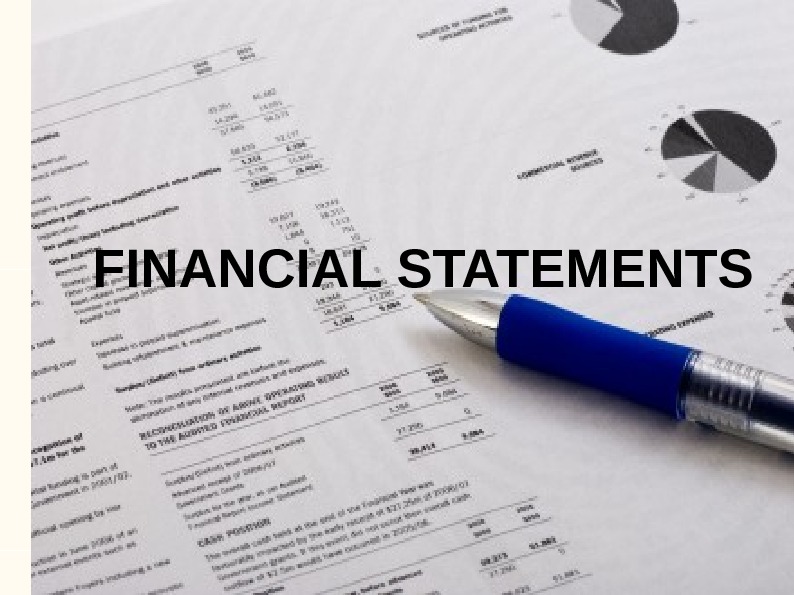
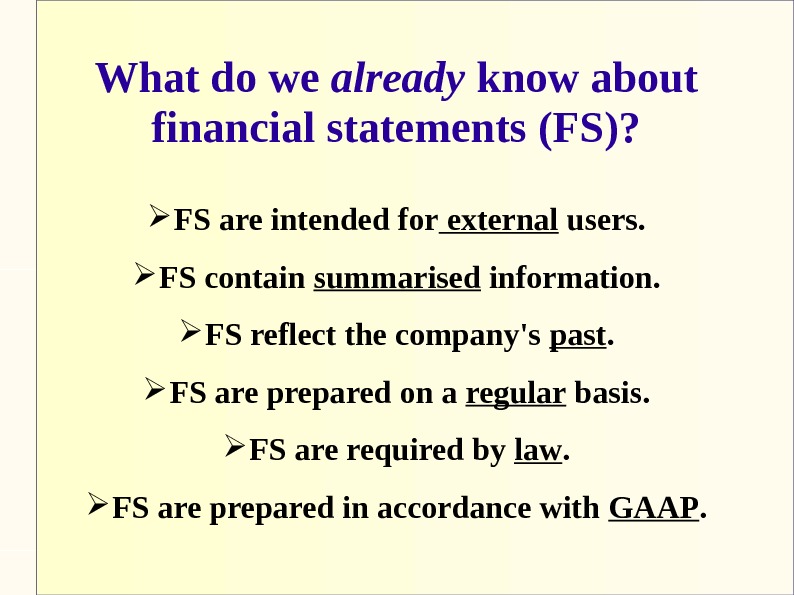


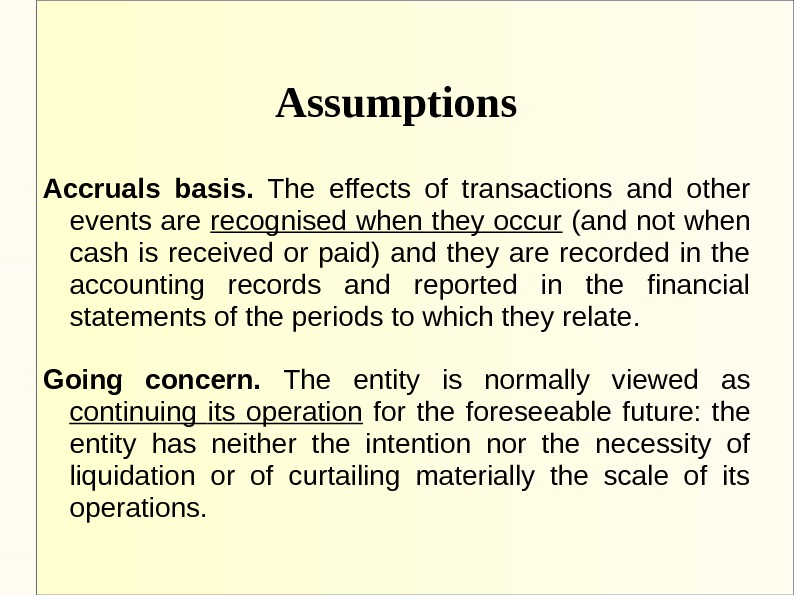
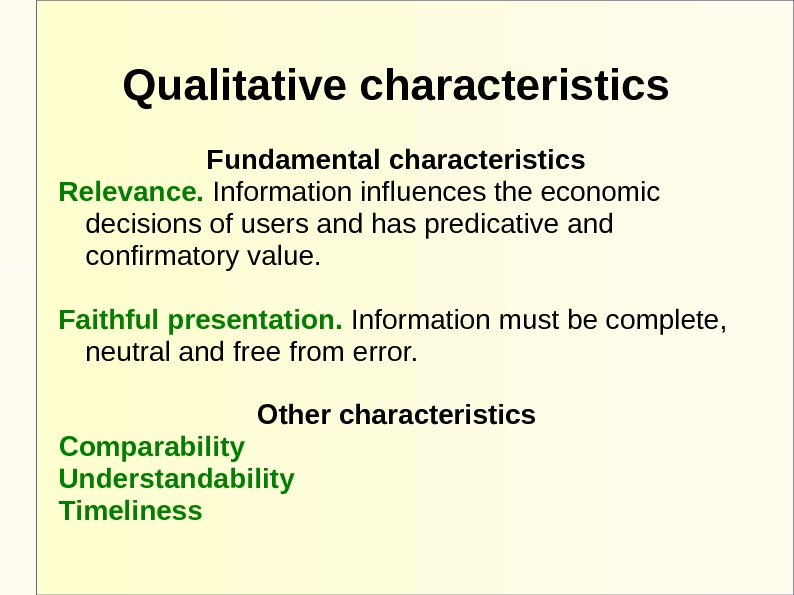
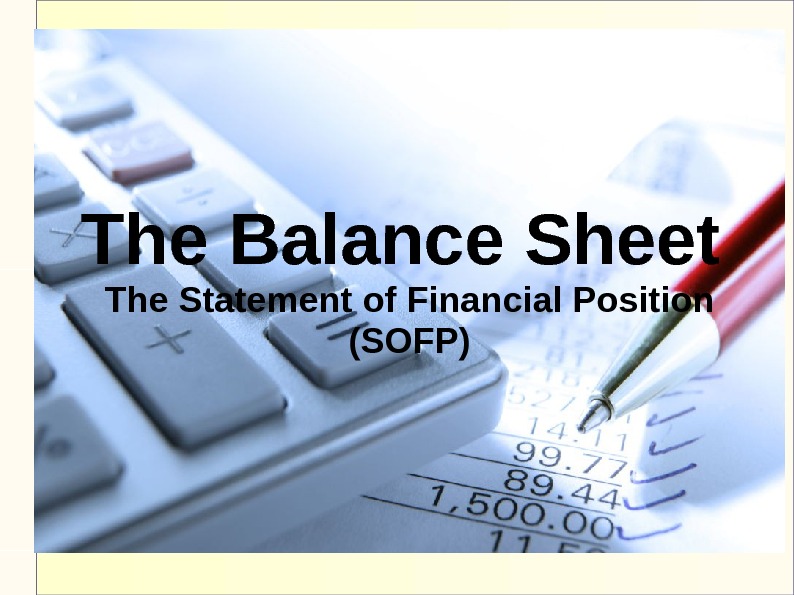

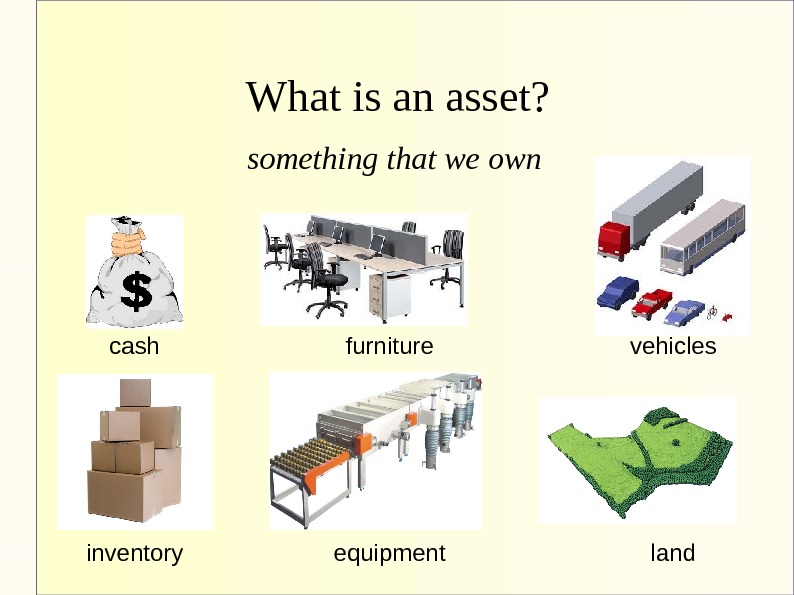
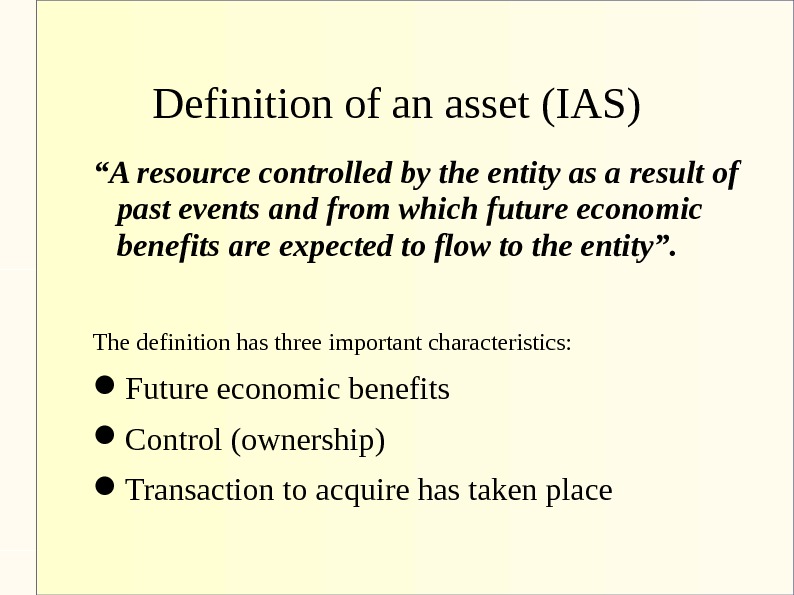


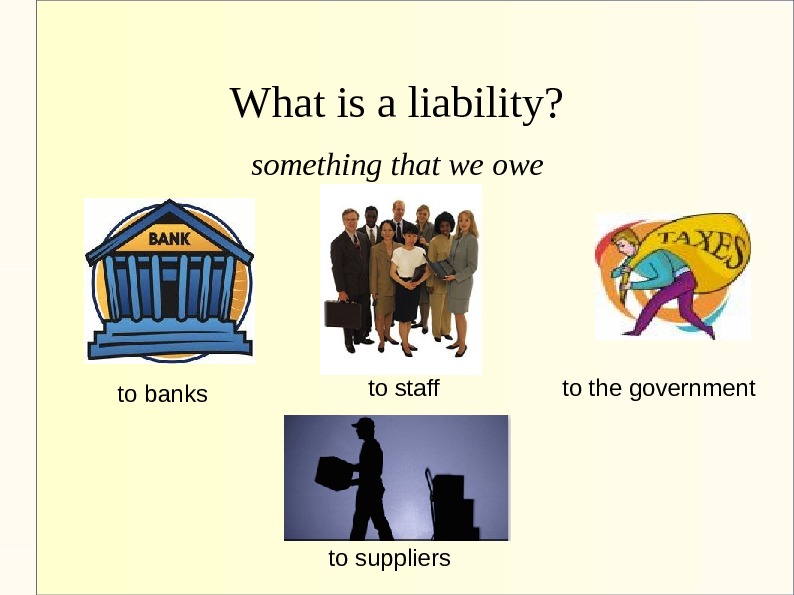
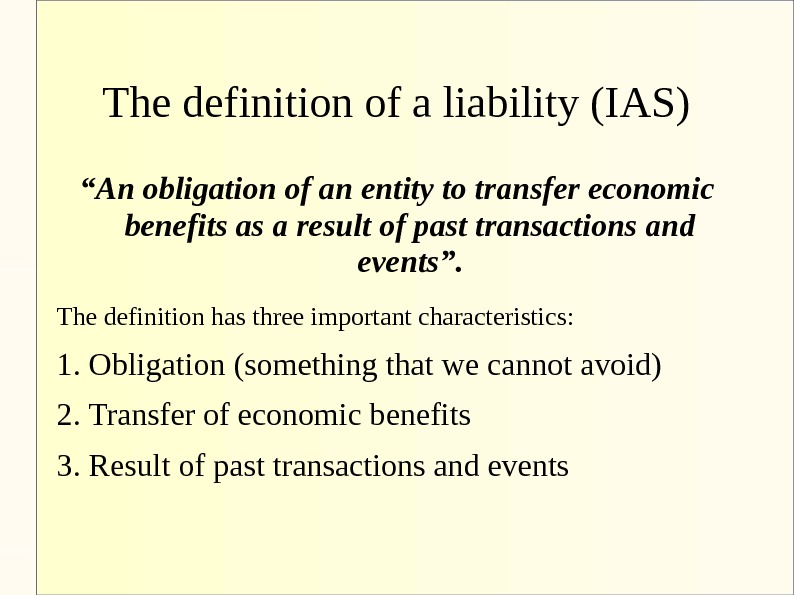
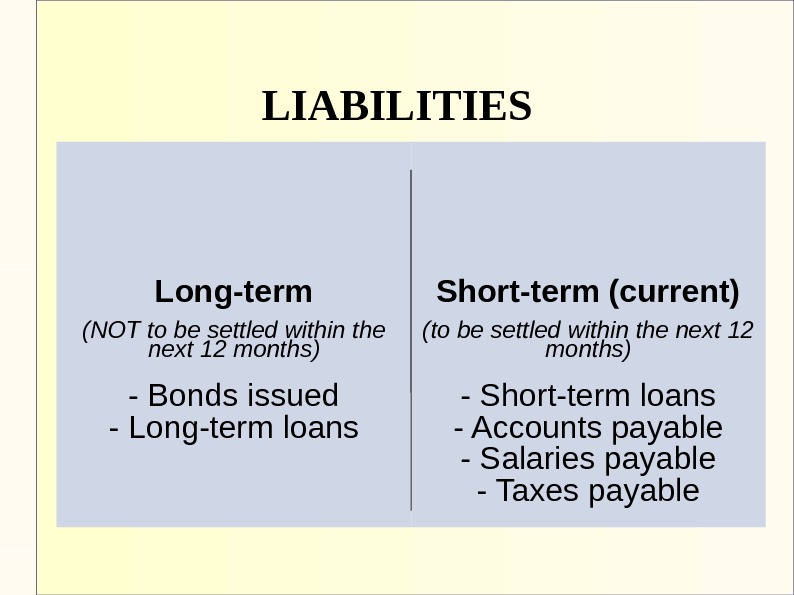
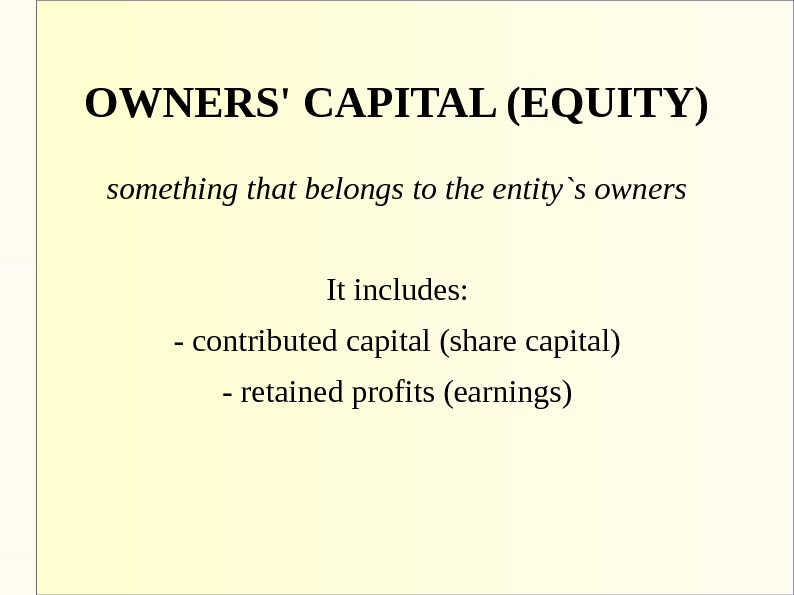

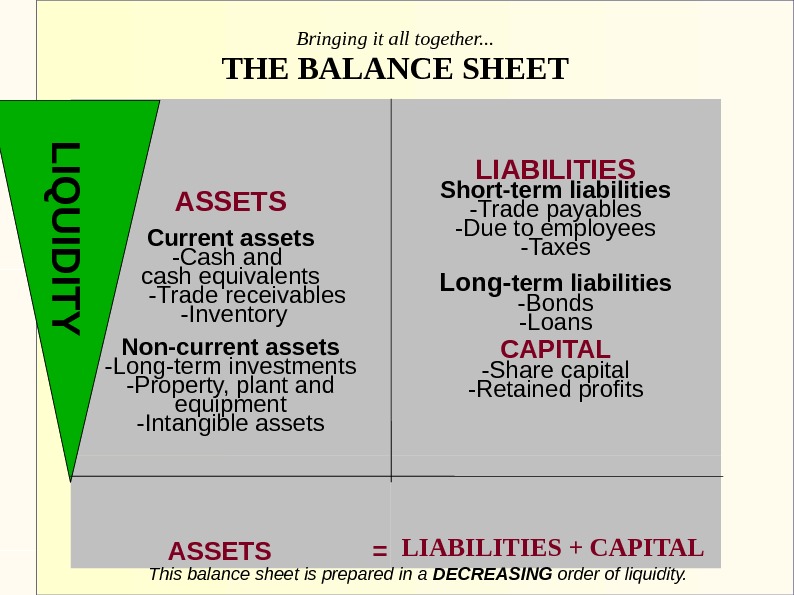


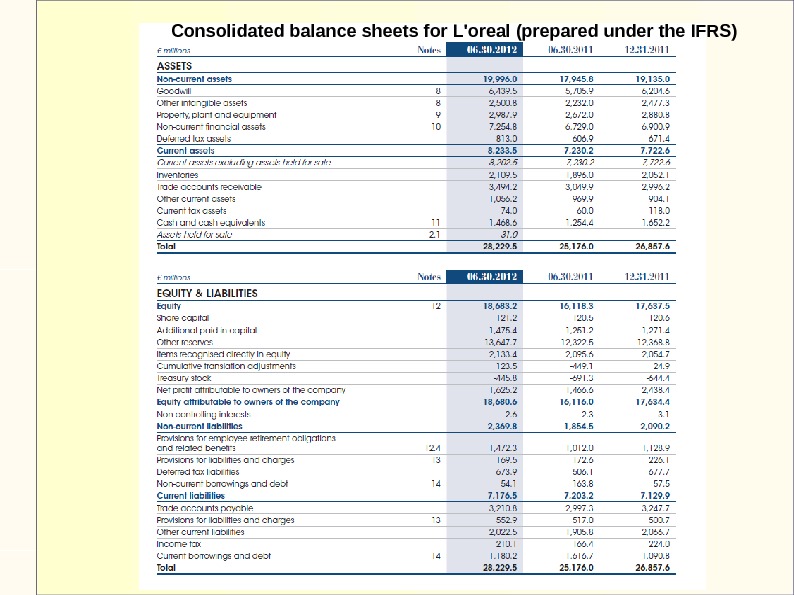
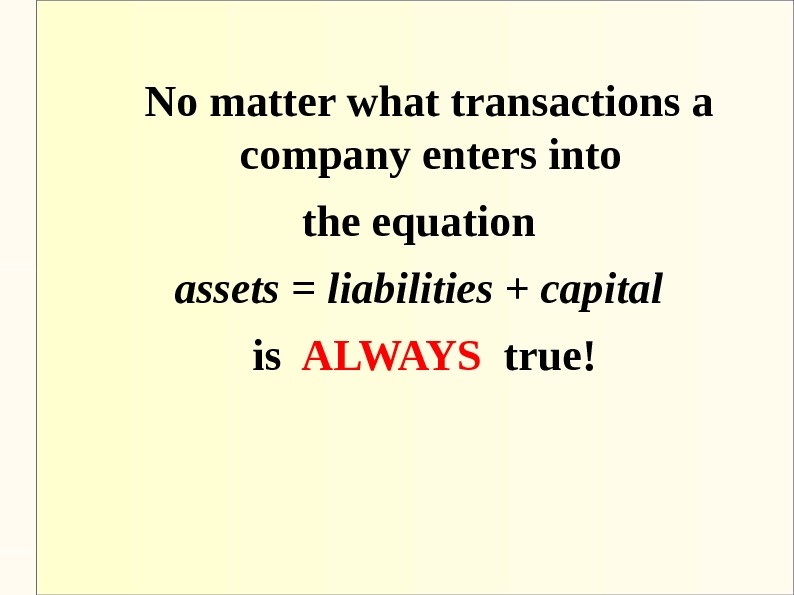
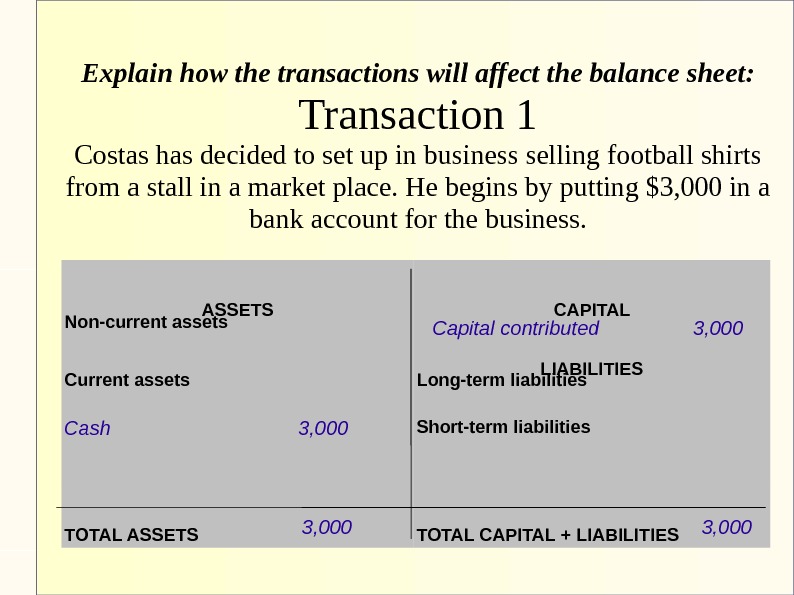

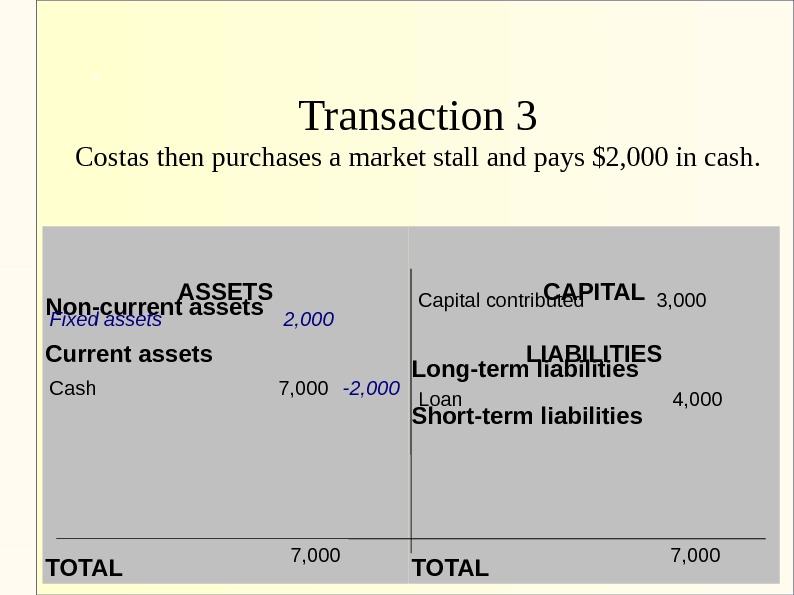
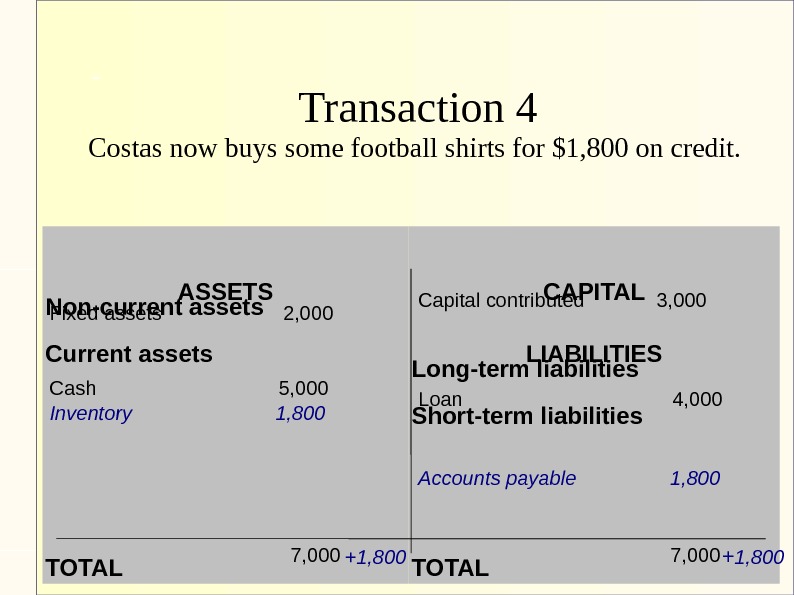
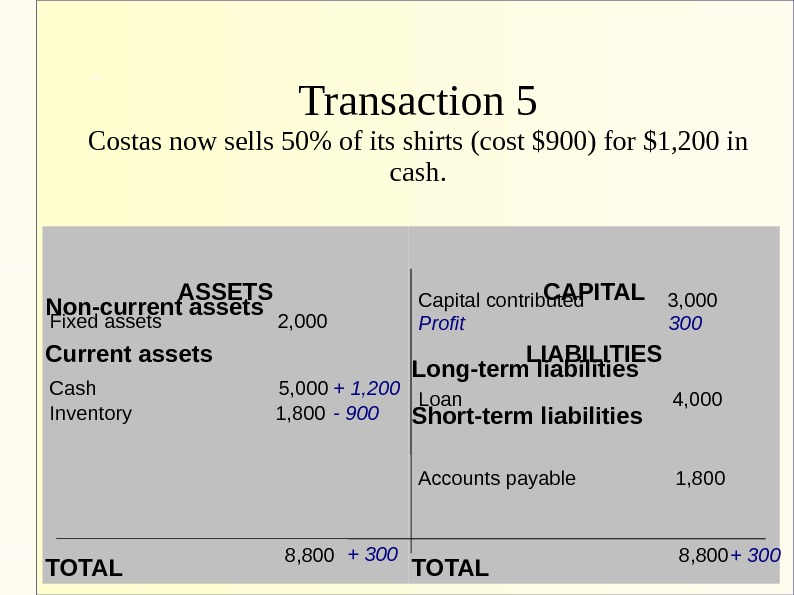
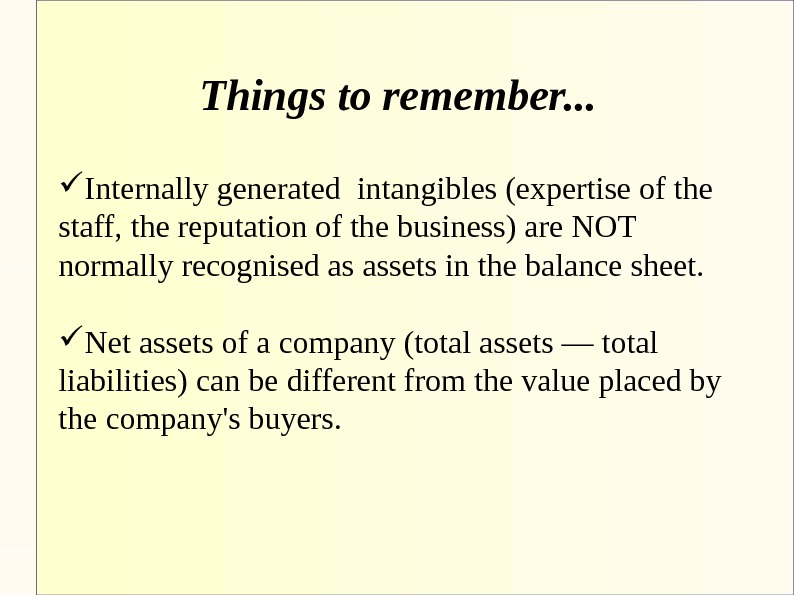
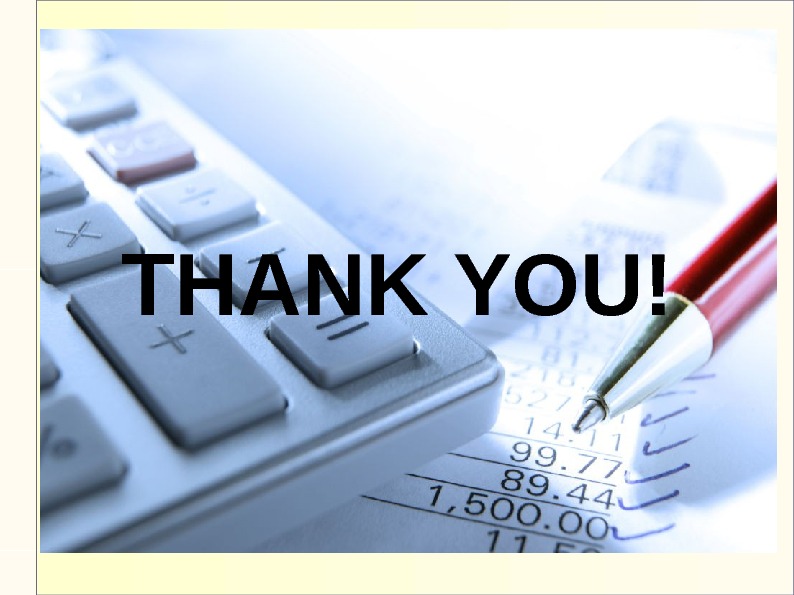
- Размер: 2.5 Mегабайта
- Количество слайдов: 29
Описание презентации Презентация balance sheet ппп по слайдам
 FINANCIAL STATEMENTS
FINANCIAL STATEMENTS
 What do we already know about financial statements (FS)? FS are intended for external users. FS contain summarised information. FS reflect the company’s past. FS are prepared on a regular basis. FS are required by law. FS are prepared in accordance with GAAP.
What do we already know about financial statements (FS)? FS are intended for external users. FS contain summarised information. FS reflect the company’s past. FS are prepared on a regular basis. FS are required by law. FS are prepared in accordance with GAAP.
 The objective of general purpose FS is to provide information about the financial position , financial performance , and cash flows of an entity that is useful to a wide range of users in making economic decisions.
The objective of general purpose FS is to provide information about the financial position , financial performance , and cash flows of an entity that is useful to a wide range of users in making economic decisions.
 Set of financial statements 1) a statement of financial position (balance sheet) 2) a statement of comprehensive income (income statement / profit and loss account) 3) a statement of cash flows 4) a statement of changes in equity 5) explanatory notes
Set of financial statements 1) a statement of financial position (balance sheet) 2) a statement of comprehensive income (income statement / profit and loss account) 3) a statement of cash flows 4) a statement of changes in equity 5) explanatory notes
 Assumptions Accruals basis. The effects of transactions and other events are recognised when they occur (and not when cash is received or paid) and they are recorded in the accounting records and reported in the financial statements of the periods to which they relate. Going concern. The entity is normally viewed as continuing its operation for the foreseeable future: the entity has neither the intention nor the necessity of liquidation or of curtailing materially the scale of its operations.
Assumptions Accruals basis. The effects of transactions and other events are recognised when they occur (and not when cash is received or paid) and they are recorded in the accounting records and reported in the financial statements of the periods to which they relate. Going concern. The entity is normally viewed as continuing its operation for the foreseeable future: the entity has neither the intention nor the necessity of liquidation or of curtailing materially the scale of its operations.
 Qualitative characteristics Fundamental characteristics Relevance. Information influences the economic decisions of users and has predicative and confirmatory value. Faithful presentation. Information must be complete, neutral and free from error. Other characteristics Comparability Understandability T imeliness
Qualitative characteristics Fundamental characteristics Relevance. Information influences the economic decisions of users and has predicative and confirmatory value. Faithful presentation. Information must be complete, neutral and free from error. Other characteristics Comparability Understandability T imeliness
 The Balance Sheet The Statement of Financial Position (SOFP)
The Balance Sheet The Statement of Financial Position (SOFP)
 The Balance Sheet ASSETS The fundamental accounting equation: Assets = Liabilities + Equity (Owners’ capital )
The Balance Sheet ASSETS The fundamental accounting equation: Assets = Liabilities + Equity (Owners’ capital )
 What is an asset? something that we own cash furniture vehicles inventory equipment land
What is an asset? something that we own cash furniture vehicles inventory equipment land
 Definition of an asset (IAS) “ A resource controlled by the entity as a result of past events and from which future economic benefits are expected to flow to the entity”. The definition has three important characteristics: Future economic benefits Control (ownership) Transaction to acquire has taken place
Definition of an asset (IAS) “ A resource controlled by the entity as a result of past events and from which future economic benefits are expected to flow to the entity”. The definition has three important characteristics: Future economic benefits Control (ownership) Transaction to acquire has taken place
 ASSETS Non-current (NOT expected to become cash within the next year) Intangible assets (licenses, patents) Property, plant and equipment / Fixed assets Long-term investments LESS liquid Сurrent (Expected to become cash within the next year) Inventory (raw materials, work-in-progress, finished goods) Accounts receivable Cash and cash equivalents MORE liquid
ASSETS Non-current (NOT expected to become cash within the next year) Intangible assets (licenses, patents) Property, plant and equipment / Fixed assets Long-term investments LESS liquid Сurrent (Expected to become cash within the next year) Inventory (raw materials, work-in-progress, finished goods) Accounts receivable Cash and cash equivalents MORE liquid
 Assets are NOT manna from heaven! Sources / Claims on assets Owners Creditors A company’s assets can be financed through borrowing (liabilities) or by paying the owners’ money (equity)A S S E T S
Assets are NOT manna from heaven! Sources / Claims on assets Owners Creditors A company’s assets can be financed through borrowing (liabilities) or by paying the owners’ money (equity)A S S E T S
 What is a liability? something that we owe to banks to staff to the government to suppliers
What is a liability? something that we owe to banks to staff to the government to suppliers
 The definition of a liability (IAS) “ An obligation of an entity to transfer economic benefits as a result of past transactions and events ”. The definition has three important characteristics: 1. Obligation (something that we cannot avoid) 2. Transfer of economic benefits 3. Result of past transactions and events
The definition of a liability (IAS) “ An obligation of an entity to transfer economic benefits as a result of past transactions and events ”. The definition has three important characteristics: 1. Obligation (something that we cannot avoid) 2. Transfer of economic benefits 3. Result of past transactions and events
 LIABILITIES Long-term (NOT to be settled within the next 12 months) — Bonds issued — Long-term loans Short-term (current) (to be settled within the next 12 months) — Short-term loans — Accounts payable — Salaries payable — Taxes payable
LIABILITIES Long-term (NOT to be settled within the next 12 months) — Bonds issued — Long-term loans Short-term (current) (to be settled within the next 12 months) — Short-term loans — Accounts payable — Salaries payable — Taxes payable
 OWNERS’ CAPITAL (EQUITY) something that belongs to the entity`s owners It includes: — contributed capital (share capital) — retained profits (earnings)
OWNERS’ CAPITAL (EQUITY) something that belongs to the entity`s owners It includes: — contributed capital (share capital) — retained profits (earnings)
 Bringing it all together. . . THE BALANCE SHEET ASSETS Non-current assets -Intangible assets -Property, plant and equipment -Long-term investments Current assets -Inventory -Trade receivables -Cash and cash equivalents CAPITAL -Share capital -Retained profits LIABILITIES Long-term liabilities -Bonds -Loans Short-term liabilities -Trade payables — Due to employees — Taxes ASSETS = CAPITAL + LIABILITIES This balance sheet is prepared in an INCREASING order of liquidity. L I Q U I D I T Y
Bringing it all together. . . THE BALANCE SHEET ASSETS Non-current assets -Intangible assets -Property, plant and equipment -Long-term investments Current assets -Inventory -Trade receivables -Cash and cash equivalents CAPITAL -Share capital -Retained profits LIABILITIES Long-term liabilities -Bonds -Loans Short-term liabilities -Trade payables — Due to employees — Taxes ASSETS = CAPITAL + LIABILITIES This balance sheet is prepared in an INCREASING order of liquidity. L I Q U I D I T Y
 ASSETS Current assets -Cash and cash equivalents -Trade receivables -Inventory Non-current assets -Long-term investments -Property, plant and equipment -Intangible assets LIABILITIES Short-term liabilities -Trade payables -Due to employees -Taxes Long- term liabilities -Bonds -Loans CAPITAL -Share capital -Retained profits ASSETS = LIABILITIES + CAPITAL Bringing it all together. . . THE BALANCE SHEET This balance sheet is prepared in a DECREASING order of liquidity. L I Q U I D I T Y
ASSETS Current assets -Cash and cash equivalents -Trade receivables -Inventory Non-current assets -Long-term investments -Property, plant and equipment -Intangible assets LIABILITIES Short-term liabilities -Trade payables -Due to employees -Taxes Long- term liabilities -Bonds -Loans CAPITAL -Share capital -Retained profits ASSETS = LIABILITIES + CAPITAL Bringing it all together. . . THE BALANCE SHEET This balance sheet is prepared in a DECREASING order of liquidity. L I Q U I D I T Y
 A balance sheet is a snapshot of a company at a moment in time. It shows the company’s financial position (assets, liabilities and equity) as of a particular (reporting) date.
A balance sheet is a snapshot of a company at a moment in time. It shows the company’s financial position (assets, liabilities and equity) as of a particular (reporting) date.
 Mechel’s balance sheet (prepared under the RAS) )
Mechel’s balance sheet (prepared under the RAS) )
 Consolidated balance sheets for L’oreal (prepared under the IFRS)
Consolidated balance sheets for L’oreal (prepared under the IFRS)
 No matter what transactions a company enters into the equation assets = liabilities + capital is ALWAYS true!
No matter what transactions a company enters into the equation assets = liabilities + capital is ALWAYS true!
 Explain how the transactions will affect the balance sheet: Transaction 1 Costas has decided to set up in business selling football shirts from a stall in a market place. He begins by putting $3, 000 in a bank account for the business. ASSETS Non-current assets Current assets CAPITAL LIABILITIES Long-term liabilities Short-term liabilities TOTAL ASSETS TOTAL CAPITAL + LIABILITIES Cash 3, 000 Capital contributed 3,
Explain how the transactions will affect the balance sheet: Transaction 1 Costas has decided to set up in business selling football shirts from a stall in a market place. He begins by putting $3, 000 in a bank account for the business. ASSETS Non-current assets Current assets CAPITAL LIABILITIES Long-term liabilities Short-term liabilities TOTAL ASSETS TOTAL CAPITAL + LIABILITIES Cash 3, 000 Capital contributed 3,
 Transaction 2 Costas then obtains a 5 -year loan of $4, 000 from his brother. ASSETS Non-current assets Current assets CAPITAL LIABILITIES Long-term liabilities Short-term liabilities TOTAL TOTAL Cash 3, 000 Capital contributed 3, 000 Loan 4, 000+ 4,
Transaction 2 Costas then obtains a 5 -year loan of $4, 000 from his brother. ASSETS Non-current assets Current assets CAPITAL LIABILITIES Long-term liabilities Short-term liabilities TOTAL TOTAL Cash 3, 000 Capital contributed 3, 000 Loan 4, 000+ 4,
 Transaction 3 Costas then purchases a market stall and pays $2, 000 in cash. ASSETS Non-current assets Current assets CAPITAL LIABILITIES Long-term liabilities Short-term liabilities TOTAL TOTAL Cash 7, 000 Capital contributed 3, 000 7, 000 Loan 4, 000 Fixed assets 2, 000 — -2,
Transaction 3 Costas then purchases a market stall and pays $2, 000 in cash. ASSETS Non-current assets Current assets CAPITAL LIABILITIES Long-term liabilities Short-term liabilities TOTAL TOTAL Cash 7, 000 Capital contributed 3, 000 7, 000 Loan 4, 000 Fixed assets 2, 000 — -2,
 Transaction 4 Costas now buys some football shirts for $1, 800 on credit. ASSETS Non-current assets Current assets CAPITAL LIABILITIES Long-term liabilities Short-term liabilities TOTAL TOTAL Cash 5, 000 Capital contributed 3, 000 7, 000 Loan 4, 000 Fixed assets 2, 000 — Inventory 1, 800 Accounts payable 1, 800 + 1,
Transaction 4 Costas now buys some football shirts for $1, 800 on credit. ASSETS Non-current assets Current assets CAPITAL LIABILITIES Long-term liabilities Short-term liabilities TOTAL TOTAL Cash 5, 000 Capital contributed 3, 000 7, 000 Loan 4, 000 Fixed assets 2, 000 — Inventory 1, 800 Accounts payable 1, 800 + 1,
 Transaction 5 Costas now sells 50% of its shirts (cost $900) for $1, 200 in cash. ASSETS Non-current assets Current assets CAPITAL LIABILITIES Long-term liabilities Short-term liabilities TOTAL TOTAL Cash 5, 000 Capital contributed 3, 000 8, 800 Loan 4, 000 Fixed assets 2, 000 — Inventory 1, 800 Accounts payable 1, 800 — 900+ 1, 200 Profit 300 +
Transaction 5 Costas now sells 50% of its shirts (cost $900) for $1, 200 in cash. ASSETS Non-current assets Current assets CAPITAL LIABILITIES Long-term liabilities Short-term liabilities TOTAL TOTAL Cash 5, 000 Capital contributed 3, 000 8, 800 Loan 4, 000 Fixed assets 2, 000 — Inventory 1, 800 Accounts payable 1, 800 — 900+ 1, 200 Profit 300 +
 Things to remember. . . Internally generated intangibles (expertise of the staff, the reputation of the business) are NOT normally recognised as assets in the balance sheet. Net assets of a company (total assets — total liabilities) can be different from the value placed by the company’s buyers.
Things to remember. . . Internally generated intangibles (expertise of the staff, the reputation of the business) are NOT normally recognised as assets in the balance sheet. Net assets of a company (total assets — total liabilities) can be different from the value placed by the company’s buyers.
 THANK YOU!
THANK YOU!

